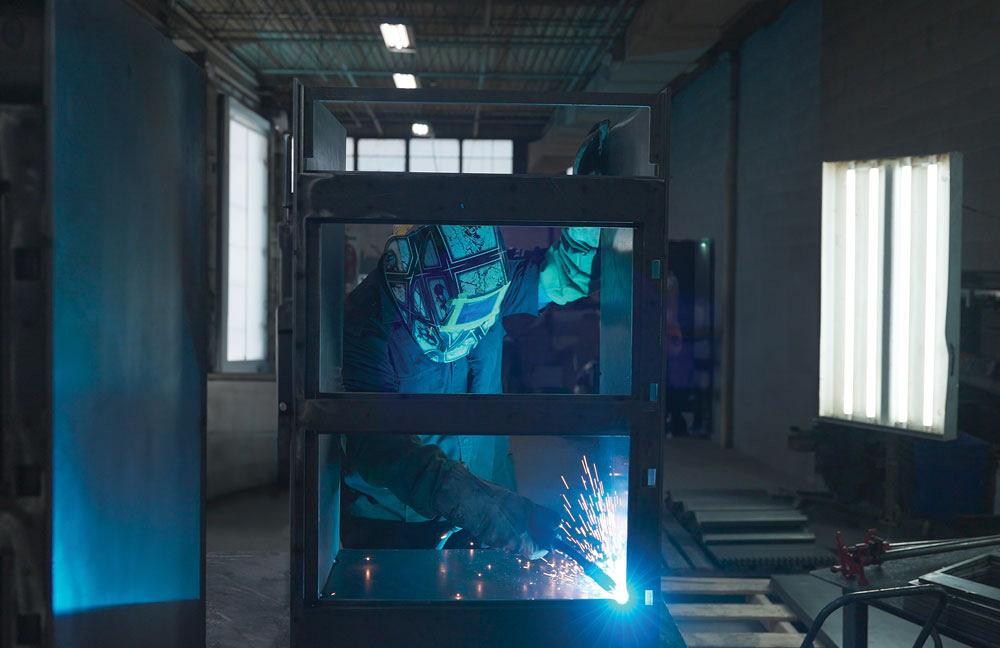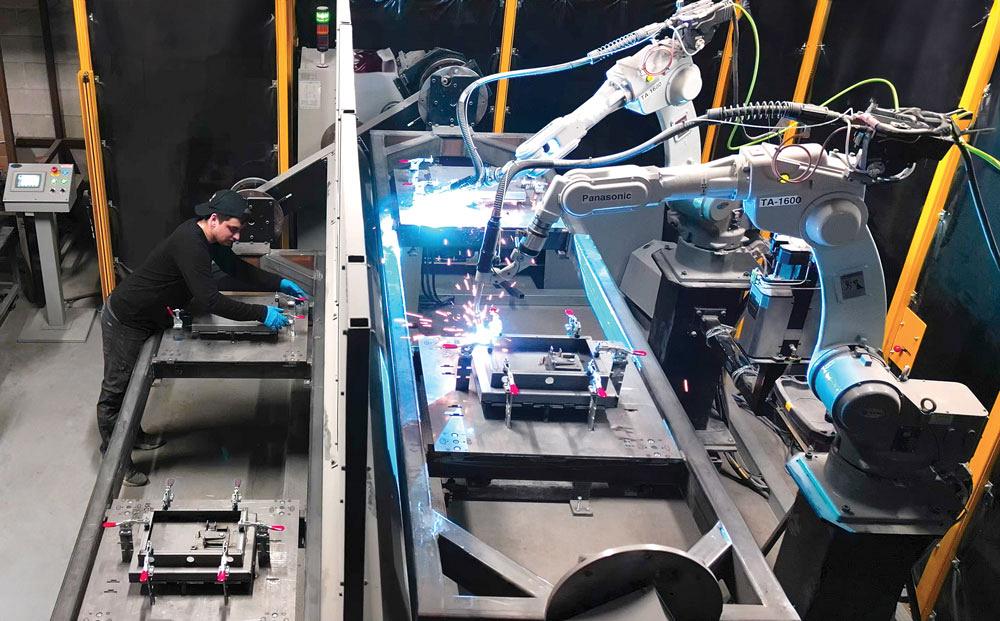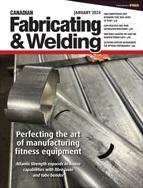Associate Editor
- FMA
- The Fabricator
- FABTECH
- Canadian Metalworking
Cracking into the process of safe manufacturing
INKAS Safe Manufacturing finds new ways to enhance security in its products
- By Lindsay Luminoso
- February 21, 2024
- Article
- Fabricating

The INKAS Safe manufacturing team features in welding, metalworking, engineering, design, and security technology, including digital lock systems. Images: INKAS
When you think of INKAS, you might immediately think of armoured vehicles. However, INKAS Group of Companies has numerous divisions focusing on various aspects of civilian safety, environmental protection, financial aid, security, logistics, fabrication, and manufacturing.
The INKAS Safe Manufacturing division, one of the largest safe manufacturers in Canada, was established in 1999 in Toronto.
“We specialize in creating a wide range of safes and security products, catering to various sectors including retailers, government agencies, financial institutions, jewelry stores, and pharmaceutical chains,” said Margarita Simkin, chairwoman and president, INKAS Safes. “Our product lineup is diverse, featuring custom luxury safes and UL-rated safes, among others. Each product is designed with the highest security standards in mind.”
In addition to safes, the company offers other security-related equipment like safe deposit boxes, fireproof filing cabinets, and an array of electronic and mechanical locks.
The product lines at INKAS are distributed through a network of locksmiths, safe technicians, and dealers across North America. It also provides services for safe owners such as installation, moving, opening, and maintenance.
“Our commitment to our customers is deeply rooted in our core values of honesty, integrity, and accountability,” said Simkin. “We understand the importance of protecting what is valuable to our clients, and we strive to offer the best in both products and services.”
The division includes a 20,000-sq.-ft., state-of-the-art manufacturing facility, which includes factory floor space for production and a dedicated administrative area for design, management, and sales. Currently, the company employs skilled labourers, engineers, designers, quality control specialists, and administrative personnel.
“Our team's skill set is diverse, encompassing expertise in welding, metalworking, engineering, design, and security technology, including digital lock systems,” said Simkin.
Inside the Safe Manufacturing Factory
“One of the unique aspects of our facility is the incorporation of advanced technologies,” said Simkin. “We utilize robotic metal bending processes, which significantly enhance precision and efficiency in manufacturing. Additionally, our facility is equipped with automated systems for lifting and moving materials, streamlining the production process. The production facility also includes CNC machinery and laser cutting.”
The company’s machinery inventory is updated on annual basis, as it is continually investing in advanced equipment like robotic assembly lines, laser cutting machines, and CNC bending and punching tools, which allow for precision, efficiency and customization in the manufacturing process.

Highly-customizable safes generally require more flexible manufacturing processes, like welding robots, and advanced equipment to accommodate unique specifications and security requirements.
When it comes to the production of safes, there is a streamlined process that the company follows:
- Design and engineering – Conceptualizing the safe's design and security features.
- Material selection – Choosing the right materials for strength and durability.
- Cutting and shaping – Using tools like lasers and CNC machines for precise cutting of materials.
- Assembly – Welding and assembling the components together.
- Finishing – Applying finishes for aesthetics and additional protection.
- Quality control – Employing rigorous testing to ensure security and durability.
Manufacturing safes has a few unique considerations. INKAS must ensure that it complies with various security standards, such as Underwriters Laboratories (UL) ratings.
“A standout feature of our latest safes is that we produce some of the smallest UL-certified safes in the world,” said Simkin. “This uniqueness reflects our commitment to innovation and our ability to adapt to the compact and efficient storage needs of our customers.”
Durability and resistance also are important factors, as it must ensure its safes are resistant to fire, water, and break-ins. Further, the company is focused on precision—a high degree of accuracy in manufacturing will help prevent vulnerabilities.
Over the years, the company has designed and developed a range of safes for various purposes, each requiring different material and manufacturing specifications.
For example, burglary- and fire-resistant safes are constructed with materials that provide a barrier against high temperatures and flames.
The company produces safes with various UL safety ratings, from Class UL-TL-15 all the up to Class UL TRTL-60x6. TR stands for torch resistance and the TL stands for tool latency. This means that these safes can withstand an attack from a tool or a torch by UL’s skilled engineers on all six sides of the safe for a specific amount of time.
“Our highly customizable safes involve a tailored approach to design and manufacturing, allowing for specific customer needs in terms of size, security features, and aesthetic preferences,” said Simkin. “These safes generally require more flexible manufacturing processes and advanced equipment to accommodate unique specifications and security requirements.”
Simkin credits the introduction of welding robots, lasers, and advanced model design and calculation technologies, such as CNC bending and punching, with revolutionizing the company’s manufacturing process.
“These technologies allow for greater customization, efficiency in production, and reduced material wastage, which is beneficial for the environment,” she said. “And because new safes and security equipment are now more customizable, we need to cater to a wider range of specific customer needs. The manufacturing process has become faster and more precise, leading to products that are not only secure but also aesthetically pleasing and environmentally friendly.”

Durability and resistance are important features, as INKAS must ensure its safes are resistant to fire, water, and break-ins. The company also is focused on precision—a high degree of accuracy in manufacturing will help prevent vulnerabilities.
Material Selection and Testing
INKAS uses a variety of materials to manufacture its safes, keeping in mind that UL certification focuses on the end result rather than the specific materials used.
“While we employ some proprietary, secret technologies in our material selection, we also use some publicly known materials, including Ultra-High-Performance Concrete (UHPC) and ballistic-grade steel,” said Simkin.
When it comes to material characteristics, every safe is different. Materials need to have high durability and strength to resist break-ins, provide fire and heat resistance, and withstand high-impact forces.
“The challenge with working with ballistic-grade steels and composite materials is that they often require specialized equipment and expertise,” said Simkin. “It also can be challenging to ensure consistency in quality and performance due the to the complex nature of these materials. Not to mention, we need to balance the need for high security while still maintaining usability and aesthetic appeal.”
To ensure its safes and security equipment meet the highest standards, the company conducts extensive testing and holds UL certification. A safe’s UL rating is based on its ability to resist attempts at entry and protect contents against fire, among other standardized benchmarks. Achieving this certification requires the company to send safes to UL, along with product specifications and blueprints. There, a specialized team develops a breach resistance test plan and performs the necessary testing to determine the safe’s rating.
“Importantly, these laboratories use the best materials and equipment available for testing, ensuring a thorough and rigorous evaluation,” said Simkin. “This process underlines our trust in UL certification as one of the world's most reliable and quality-focused standards.”
Future Opportunities For Safe Manufacturing
The INKAS Safe Manufacturing journey has been marked by continuous growth and adaptation. A key area of the company’s success is its focus on upgrading existing product lines to meet existing and future market challenges.
“This process of continuous improvement has not only improved our existing products but has also led us to develop new models and explore untapped niches,” said Simkin.
For example, a recent development has been the company’s expansion into creating specialized doors and panic rooms. These products represent a new venture for INKAS and have broadened its expertise beyond traditional safes to include the safety and security of homes and businesses.
“A key area of focus for us going forward will be on vault doors and panic rooms, as we recognize the increasing demand in these areas,” said Simkin. “We also plan to invest more in protecting against torch attacks, acknowledging the rapid development in torch technology and its implications for security. By addressing these areas, we aim to continue our trajectory of success and innovation in the safe manufacturing industry.”
In the next year, the company also plans to increase production speed to better meet customer demands more efficiently. Additionally, INKAS plans to expand its storage capacity to facilitate faster delivery of products to clients.
“However, all of our successes have not come without challenges,” said Simkin. “Keeping pace with rapidly changing security technologies and customer expectations requires constant vigilance and innovation. We've had to adapt quickly to these changes, ensuring that our products not only meet but exceed the latest security standards. But we are excited about the future and the opportunities that lie ahead in safe manufacturing.”
Associate Editor Lindsay Luminoso can be reached at lluminoso@fmamfg.org.
INKAS Safe Manufacturing, www.inkassafes.com
About the Author

Lindsay Luminoso
1154 Warden Avenue
Toronto, M1R 0A1 Canada
Lindsay Luminoso, associate editor, contributes to both Canadian Metalworking and Canadian Fabricating & Welding. She worked as an associate editor/web editor, at Canadian Metalworking from 2014-2016 and was most recently an associate editor at Design Engineering.
Luminoso has a bachelor of arts from Carleton University, a bachelor of education from Ottawa University, and a graduate certificate in book, magazine, and digital publishing from Centennial College.
subscribe now


Keep up to date with the latest news, events, and technology for all things metal from our pair of monthly magazines written specifically for Canadian manufacturers!
Start Your Free Subscription- Trending Articles
Aluminum MIG welding wire upgraded with a proprietary and patented surface treatment technology

Achieving success with mechanized plasma cutting

Hypertherm Associates partners with Rapyuta Robotics

Brushless copper tubing cutter adjusts to ODs up to 2-1/8 in.

Gema welcomes controller

- Industry Events
MME Winnipeg
- April 30, 2024
- Winnipeg, ON Canada
CTMA Economic Uncertainty: Helping You Navigate Windsor Seminar
- April 30, 2024
- Windsor, ON Canada
CTMA Economic Uncertainty: Helping You Navigate Kitchener Seminar
- May 2, 2024
- Kitchener, ON Canada
Automate 2024
- May 6 - 9, 2024
- Chicago, IL
ANCA Open House
- May 7 - 8, 2024
- Wixom, MI















